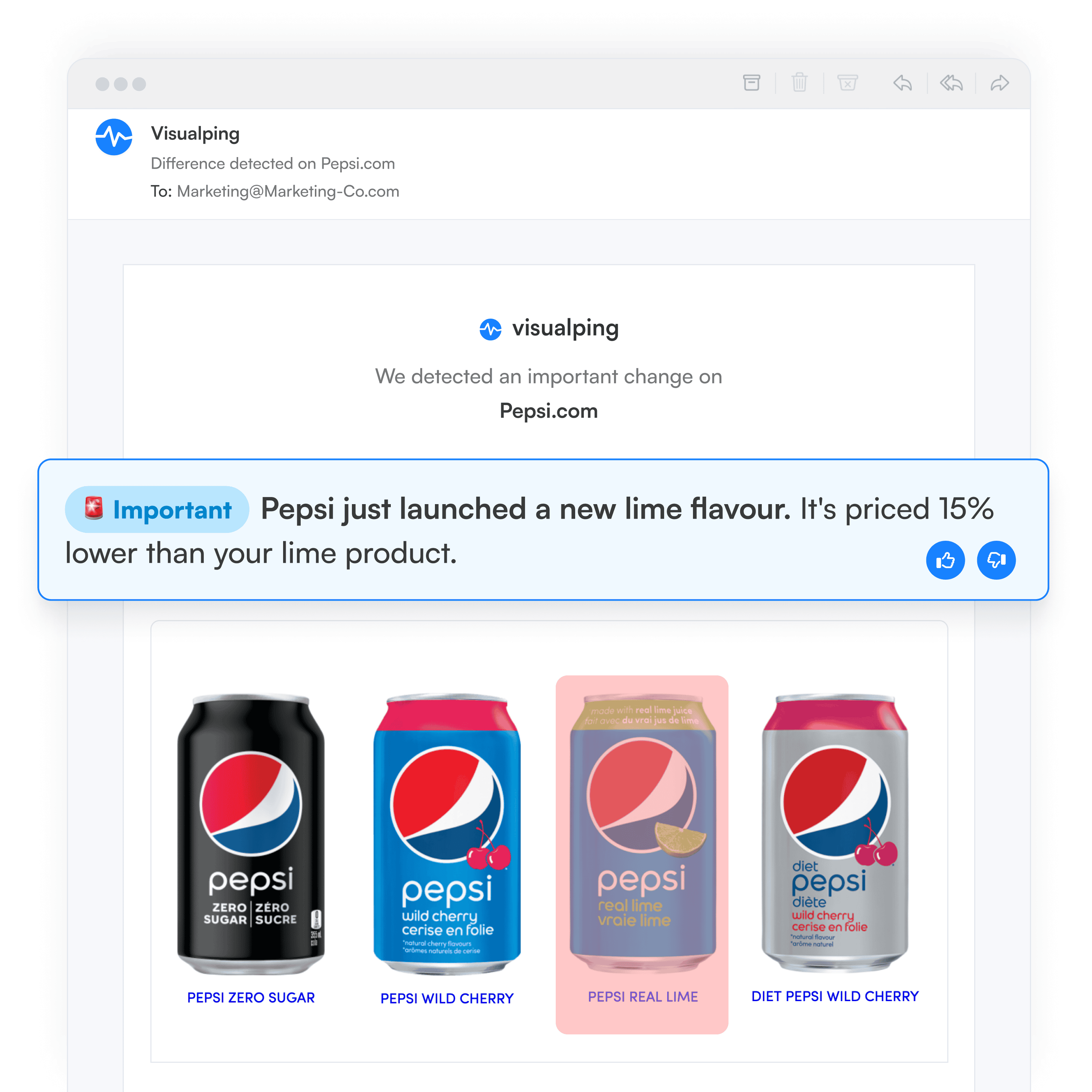Top Competitor Website Analysis Tools in 2025
By Emily Fenton
Updated December 14, 2023

Introduction
Competitor analysis tools play a vital role in helping businesses get crucial insights in their competitors and the overall market. Automated competitor tools make it easier to drill down on the websites of your competition, in particular, which can uncover valuable insights regarding pricing, products, upcoming launches and shifts in marketing strategies.
You can also learn about the performance, audience engagement, and search engine optimization of your competitors’ websites. This intel can inform your own business decisions, so you can stay relevant and competitive, as well as tell you something about customer preferences and overall industry trends.
But, with all the software options available, it can be a little overwhelming finding the right solution for you. These tools also specialize in different things, and so it’s important to evaluate the tools based on your team’s goals.
In this article, we’ll discuss some of the insights you can uncover from analyzing your competitors’ websites, before then summarizing the top competitor website analysis tools to help your business stay ahead of the curve.
Why You Should Analyze Competitor Websites
The first thing you need to know is that there are many different ways you can track a website.
Depending on your goals, there are all kinds of competitor tools that can help you analyze the information you want to know. We’ll get into that in a bit.
Depending on what you’re after, you can keep a lookout for website content updates, like the blog roll, new design updates, key content on the homepage or SEO updates, like new keywords in their headers, or updated meta descriptions, HTML titles and robots.txt.
Maybe you want to drill down into more technical data, like their software technology their website is using, your competitors’ backlink profile or traffic.
Let’s quickly highlight some of the ways you can monitor and analyze competitor websites for competitive intelligence.
Homepage Updates are Usually a Big Deal
If your competitor updates their homepage, then a high bar has to be met for them to do so. Monitor your competitor’s home page for updates to their main headline or imagery, new special notices, or even subtle changes to the content lower down the page, such as customer testimonials. You can be sure that the change you are detecting is the result of a careful decision.
Pricing Changes Help You Stay Competitive
How you price your products and services is one of the big ways you can maintain your competitive edge. To do that, you should know about updates to your competitors’ products and services, so you can ensure your pricing is still strategic.
In addition, especially in sales, the pricing page tends to be one of those “special” pages that is created with a ton of careful thought, and only updated when something important is changing. Track your competitors’ pricing pages to know about any key shifts in their pricing strategies.
These pages are typically dense with detail, and manually rechecking them for any updates is time-consuming and inefficient. An AI website monitoring tool like Visualping is super helpful for automatically monitoring competitor pages for you, and notifying you of changes, so you can save time, while staying in the know.

Navigation Updates Tell You Where they Want Traffic
Like the home page or pricing page, a company’s navigation changes when they are trying to direct significant attention to something important. Be sure to use Visualping’s advanced features to reveal updates to navigation elements and monitor only the specific dropdown(s) you care about.
Executive Team Page Changes Indicate New Investments
Most companies feature their executive team on their website. Changes to the “team page” can tell you when there’s a key departure, or hire. These updates can tell you about where your competitors are feeling changes are warranted, where bigger investments are needed, or where those investments have already begun with a new hire.
Press releases Tell You Where They’re Trying to Stand Out
Press release pages are a no-brainer to monitor. Corporate updates from a press release page can keep you up-to-date on the latest awards, partnerships, releases, and corporate development activities. You can see the bets your competitor is making, and where they’re trying to stand out.
Importance of Using Automated Website Analysis Tools
Traditional approaches to competitor analysis, like manually rechecking competitor websites and recording your observations, are time-consuming and inefficient. There’s also plenty of room for human error, and accidentally missing an important update.
Competitor monitoring and analysis is no longer a luxury but a necessity for businesses. In order to do so efficiently, automated tools have become the industry norm.
You get the insights, without having to do the tedious work yourself.
Here’s our list of the top competitor website analysis tools to use in 2024.
Top Competitor Website Analysis Tools
Visualping
Getting inspired by UX and visual changes on competitors’ websites

Visualping is a powerful AI solution for staying on top of your competition’s websites.
The competitor monitoring tool automatically checks web pages for changes. When Visualping detects a change, it sends you an email alert, with an AI-generated summary of the change, distilled in two to three lines. It also includes a screenshot of the change, the changes highlighted, so it's easy to understand the update.

By staying aware of the latest updates on your competitors’ websites, Visualping sets you up for being able to analyze the exact, specific competitor information your team wants to focus on.
Because of the screenshot feature, Visualping is an excellent option for getting inspired by UX and CRO tweaks on competitors’ websites.
You can observe how your competitors are trying to squeeze more out of every visitor to their website. In other words, you can look for user experience (UX) and conversion rate optimization (CRO) tweaks that you can adopt without having to do all the research and A/B testing.
But, the screenshots aside, the email alerts also include an AI-generated summary of the changes, making it easier for you to understand the update more quickly and easier.
Pricing
Visualping offers several flexible subscription options, starting at $25/month, which lets you monitor up to 100 pages, with a max frequency of every 15 minutes (5,000 available checks/month).
Ahrefs
Drilling Down on Website SEO Data to Improve Your Site’s Search Performance
Ahrefs is a strong SEO toolset with up-to-date data on the search performance of competitors’ websites. But as well as getting a breakdown of how your competitors are doing in the search, you can drill down on the website data behind their performance – like how many backlinks their web domain has, the keywords they do and don’t rank for, and more.
You can see where your competitors get their backlinks from, so you can replicate their tactics or go after their links. You can see how well your organic search is, relative to competitors, and even find content gaps between you and your competitors.
My favorite functionality: Finding content gaps between you and your competitors This feature shows keywords for which your competitors rank but you don’t. These are called content gaps and can give you proven content ideas for your content planning.
Pricing
Drilling into website SEO data isn’t cheap. Ahrefs’ cheapest subscription starts at $99/month.
BuiltWith
Checking any Websites’ Tech Stacks
BuiltWith is a competitor analysis tool that helps you identify the technologies any website is using, like advertising platforms, payment systems, web servers, and CDNs. You can use it to identify the niche advertising platforms your competitors use, and see if you can advertise there too.
Pricing
Plans with BuiltWith start at $295/month.
Similarweb
Getting a Good Look at Your Competitors’ Traffic
Similarweb is a competitor website analysis software that makes researching your competition’s website traffic super easy and fast. It shows you what’s happening right now by revealing the most up-to-date traffic data, detailed visitor behavior, plus paid advertising, affiliate, social, and SEO content strategies.
For this reason, it’s a great solution for getting a birds’ eye view of the industry landscape.
You can also dig deeper into your competitor’s audience by accessing geographic and demographic data to understand how and where to meet your audience. You can even see the marketing channels delivering the most traffic within your industry.
Pricing
The most basic starter plan is $125/month. The other option for individuals and startups is $333/month.
BuzzSumo
Best Uncovering Content Opportunities to Improve Your Organic Search
A great way to analyze your competitors’ websites is to see which of their web content is performing well, and you can do this with BuzzSumo. It’s a website content analysis tool that lets you see which content has the best engagement, and outreach gaps across search.
You can look at high-performing posts, niche keywords, trending stories, and customer questions to learn what content resonates with your target audience. Use those insights to elevate your own storytelling on your website content to improve your search performance.
Pricing
The most basic plan is for marketers, with a focus on content creation, starting at $199/month.
Feedly
Getting Content Ideas from Competitor Blog Content
You may be interested in your competitors’ blog for various reasons – content inspiration, insights about what your audience is interested in, indications of their future plans and shifts in their branding and marketing messages for competitive intelligence.
If you’re looking for a way to keep an eye on a competitor’s content without manually checking up on it, Feedly is a simple, but convenient, way to do that.
It’s a content aggregator that stores and organizes content as it’s published, including that of your competitors. This allows you to see hot topics covered by the competition, all on one page.
Pricing
Besides the free option, you can start getting some premium features for just $6/month.
The Bottomline
Competitor website analysis tools make it much easier for businesses to get crucial insights on the competition and overall market. Competitor websites are rich with information on everything from pricing, content, products, upcoming launches and shifts in marketing strategies.
Make sure you set you and your team’s goals ahead of evaluating which tools you would like to purchase, as there are many different website analysis tools that help you spy on the competition in different ways.
Want to monitor web changes that impact your business?
Sign up with Visualping to get alerted of important updates, from anywhere online.
Emily Fenton
Emily is the Product Marketing Manager at Visualping. She has a degree in English Literature and a Masters in Management. When she’s not researching and writing about all things Visualping, she loves exploring new restaurants, playing guitar and petting her cats.